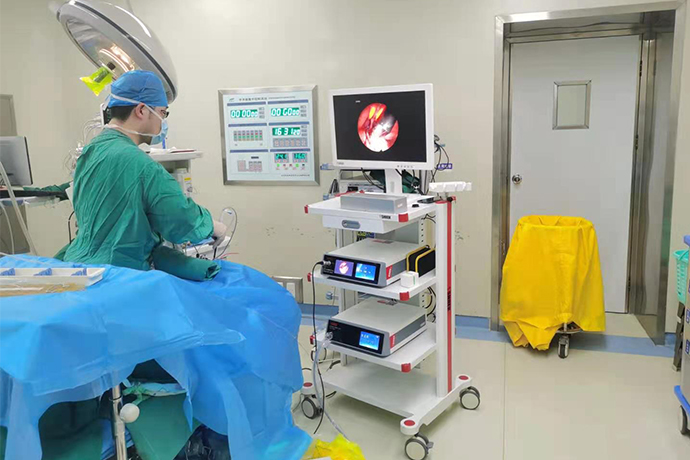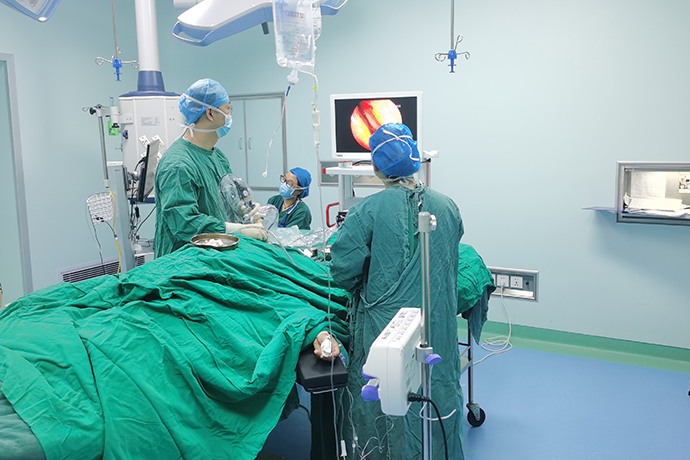【ENT】Polyps
Release time: 27 Apr 2022 Author:Shrek
Nasal polyps: The edema of the nasal mucosa protrudes into the nasal cavity and forms a vegetation. It occurs in the ethmoid sinus, maxillary sinus, free edge of the middle turbinate, uncinate process in the middle meatus, ethmoid vesicle, and semilunar fissure. The incidence rate is 1% to 4% of the total population, and it can be single or multiple. Nasal polyps have a strong tendency to recur, and the postoperative recurrence rate can reach 15% to 40%. A tumor formed by extreme edema and hypertrophy of the nasal cavity and sinus mucosa.

Clinical manifestations
Progressive persistent nasal congestion, unilateral or bilateral,
decreased sense of smell,
rhinorrhea
Obstructive nasal sound, snoring during sleep.
"Frog Nose"
Tinnitus, hearing loss
Nasal polyps are more common on both sides and less on one side. A common symptom is persistent nasal congestion, which increases with the size of the polyp. Increased nasal secretions, accompanied by sneezing, secretions may be serous, mucus, such as concurrent sinus infection, the secretions may be purulent. A lot of smell disorders. Those with severe nasal congestion may speak with an obstructive nasal sound and snore during sleep. Elderly people with polyp pedicles can feel something in the nasal cavity moving with the breath. Posterior nostril polyps can cause difficulty in exhaling through the nose when exhaling, and if the polyps block the mouth of the Eustachian tube, it can cause tinnitus and hearing loss. Polyps that block the drainage of the sinuses can cause sinusitis, and patients experience pain and discomfort in the back of the nose, forehead, and cheeks.
Signs
In the nasal cavity, one or more new organisms with smooth surface, gray-white or light red translucent can be seen (the smaller ones can be found after the inferior turbinate is retracted), which is like fresh lychee flesh, soft to the touch, not easy to bleed, movable, and non-tender. The polypoid change of the middle turbinate is inseparable from the middle turbinate, slightly hard and slightly red in color.
Posterior nostril polyps require nasopharyngoscopy, and the above-mentioned typical lesions are often found in one posterior nostril, mostly single.
Etiology
1. The middle meatus microenvironment theory The middle meatus microenvironment space is narrow and uneven, and the inhaled airflow is easy to form flow here; the ciliary function is weakened, and the ciliary activity is hindered; the blood flow of the middle meatus mucosa is significantly reduced compared with other parts of the nose. The natural defense function of the middle meatus is weakened, and the local area is easily damaged by harmful factors, which creates conditions for the formation of nasal polyps.
2. Nasal allergy In nasal polyp tissue, more mast cells, eosinophils and IqE-producing cells can be found, and the level of gE in the fluid increases, suggesting that local allergy has a certain role.
3. Nearly 90% of nasal polyps with eosinophilic inflammation have more eosinophil infiltration, suggesting that nasal polyps are closely related to the increase of these cells.
4. The bacterial superantigen theory Staphylococcus aureus is one of the common symbiotic bacteria in the nasal cavity. Staphylococcus aureus enterotoxin can directly activate a large number of Th2 cells, B cells, eosinophils and mast cells in the nasal mucosa of the middle meatus to synthesize and release a large number of pro-inflammatory cytokines, aggravating the local inflammatory response in the middle meatus. Stimulates the formation of polyps.
5. Genetic factors The pathogenesis of nasal polyps is still unclear, and some reports suggest that there may be potential effects of genetic factors. Nasal polyps are usually familial, suggesting that there are genetic or environmental factors in the pathogenesis of nasal polyps.
CT scan
A CT scan can show the full extent of the polyp, which may not be fully understood by physical examination alone. Imaging is also required to plan surgical treatment. On CT scans, nasal polyps typically have an attenuation of 10-18 Hunsfield units, which is similar to that of mucus. Nasal polyps may have calcifications.
Differential diagnosis
Other disorders can mimic the appearance of nasal polyps and should be considered if a lump is seen on examination. Examples include encephalocele, glioma, inverted papilloma, and cancer. Early biopsy of unilateral nasal polyps is recommended to rule out more serious conditions such as cancer, papilloma, or fungal sinusitis.
Treat
Glucocorticoid therapy:
1. Those with smaller initial polyps or lighter turbinate polyps: Oral prednisone 30mg/day for 7 days, and then use nasal spray of Nacoling, 50~100ug each time, 3~4 times a day. Prevent polyps from growing and disappear and control recurrence.
2. Massive polyps that block the common nasal passage: Oral prednisone 30~60mg/day for 2 weeks.
3. After operation: spray into the nasal cavity, twice a day, for 1 to 2 months.
Surgery: Endoscopic Nasal Surgery:
1. Simple nasal polyp removal. For those with clear roots and no previous history of nasal polypectomy. Under local anesthesia, use a nasal polyp snare to cover the pedicle of the polyp, tighten it, and pull it out from the inside of the nose.
2, sinus endoscopic sinus opening, polyp removal. It is mainly suitable for the ethmoid sinus mucosa that has been replaced by polyp tissue and who have a history of multiple nasal polyps removal. During the operation, the ethmoid sinus was fully opened, and the polyps in the sinus were completely removed.
Indications for surgery:
Nasal polyps from the middle turbinate or middle meatus, unilateral or bilateral, or posterior nostril polyps. If the nasal cavity has been mostly or completely blocked, which affects the physiological function of the nose, surgery should be performed first.
Contraindications to surgery:
Cardiovascular disease or other serious systemic diseases, such as asthma attack, hemorrhagic disease or acute inflammation.
Postoperative management of nasal endoscopy
Early postoperative manifestations:
On the day after the operation, there was a little blood oozing from the nasal cavity, head pain, periorbital pain, and mouth breathing due to nasal packing. After the nasal packing is removed, the above symptoms can improve. Usually the time for nasal packing removal is 24--48 hours. Early postoperative mucosal swelling and exudation. Two days after the nasal packing was removed, the oozing blood from the surgical wound coagulated and hardened in the nasal cavity, forming a black blood scab.

- Recommended news
- 【General Surgery Laparoscopy】Cholecystectomy
- Surgery Steps of Hysteroscopy for Intrauterine Adhesion
- [Gynecological Hysteroscopy] Techniques for Preventing and Treating Complications of Hysteroscopic Surgery
- [Gynecological Hysteroscopy] Hysteroscopic Adhesiolysis
- [Gynecological Hysteroscopy] IUD Removal under Hysteroscopy